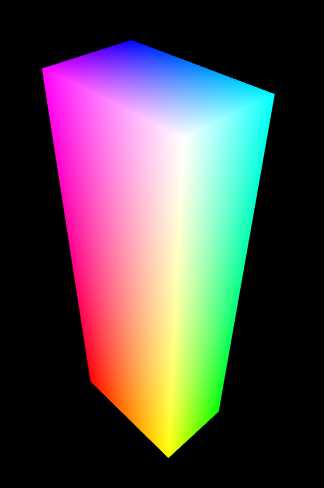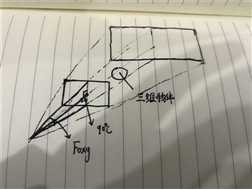标签:lan 接口 utf-8 uri [1] 讲解 att 坐标系 http
目录
看了不少的关于WebGL/OpenGL的资料,笔者发现这些资料在讲解图形变换的时候都讲了很多的原理,然后举出一个特别简单的实例(坐标是1.0,0.5的那种)来讲解。确实一看就懂,但用到实际的场景之中就一脸懵逼了(比如地形的三维坐标都是很大的数字)。所以笔者这里结合一个具体的实例,总结下WebGL/OpenGL中,关于模型变换、视图变换、投影变换的设置技巧。
绘制任何复杂的场景之前,都可以先绘制出其包围盒,能应用于包围盒的图形变换,基本上就能用于该场景了,因此,笔者这里绘制一幅地形的包围盒。它的最大最小范围为:
//包围盒范围
var minX = 399589.072;
var maxX = 400469.072;
var minY = 3995118.062;
var maxY = 3997558.062;
var minZ = 732;
var maxZ = 1268;WebGL是OpenGL的子集,因此我这里直接用WebGL的例子,但是各种接口函数跟OpenGL是非常类似的,尤其是图形变换的函数。
<!DOCTYPE html>
<html lang="zh">
<head>
<meta charset="utf-8" />
<title>Hello cube</title>
</head>
<body onload="main()">
<canvas id="webgl" width="600" height="600">
Please use a browser that supports "canvas"
</canvas>
<script src="lib/webgl-utils.js"></script>
<script src="lib/webgl-debug.js"></script>
<script src="lib/cuon-utils.js"></script>
<script src="lib/cuon-matrix.js"></script>
<script src="Cube.js"></script>
</body>
</html>
// Vertex shader program
var VSHADER_SOURCE =
‘attribute vec4 a_Position;\n‘ +
‘attribute vec4 a_Color;\n‘ +
‘uniform mat4 u_MvpMatrix;\n‘ +
‘varying vec4 v_Color;\n‘ +
‘void main() {\n‘ +
‘ gl_Position = u_MvpMatrix * a_Position;\n‘ +
‘ v_Color = a_Color;\n‘ +
‘}\n‘;
// Fragment shader program
var FSHADER_SOURCE =
‘#ifdef GL_ES\n‘ +
‘precision mediump float;\n‘ +
‘#endif\n‘ +
‘varying vec4 v_Color;\n‘ +
‘void main() {\n‘ +
‘ gl_FragColor = v_Color;\n‘ +
‘}\n‘;
//包围盒范围
var minX = 399589.072;
var maxX = 400469.072;
var minY = 3995118.062;
var maxY = 3997558.062;
var minZ = 732;
var maxZ = 1268;
//包围盒中心
var cx = (minX + maxX) / 2.0;
var cy = (minY + maxY) / 2.0;
var cz = (minZ + maxZ) / 2.0;
//当前lookAt()函数初始视点的高度
var eyeHight = 2000.0;
//根据视点高度算出setPerspective()函数的合理角度
var fovy = (maxY - minY) / 2.0 / eyeHight;
fovy = 180.0 / Math.PI * Math.atan(fovy) * 2;
//setPerspective()远截面
var far = 3000;
//
function main() {
// Retrieve <canvas> element
var canvas = document.getElementById(‘webgl‘);
// Get the rendering context for WebGL
var gl = getWebGLContext(canvas);
if (!gl) {
console.log(‘Failed to get the rendering context for WebGL‘);
return;
}
// Initialize shaders
if (!initShaders(gl, VSHADER_SOURCE, FSHADER_SOURCE)) {
console.log(‘Failed to intialize shaders.‘);
return;
}
// Set the vertex coordinates and color
var n = initVertexBuffers(gl);
if (n < 0) {
console.log(‘Failed to set the vertex information‘);
return;
}
// Get the storage location of u_MvpMatrix
var u_MvpMatrix = gl.getUniformLocation(gl.program, ‘u_MvpMatrix‘);
if (!u_MvpMatrix) {
console.log(‘Failed to get the storage location of u_MvpMatrix‘);
return;
}
// Register the event handler
var currentAngle = [0.0, 0.0]; // Current rotation angle ([x-axis, y-axis] degrees)
initEventHandlers(canvas, currentAngle);
// Set clear color and enable hidden surface removal
gl.clearColor(0.0, 0.0, 0.0, 1.0);
gl.enable(gl.DEPTH_TEST);
// Start drawing
var tick = function () {
//setPerspective()宽高比
var aspect = canvas.width / canvas.height;
//
draw(gl, n, aspect, u_MvpMatrix, currentAngle);
requestAnimationFrame(tick, canvas);
};
tick();
}
function initEventHandlers(canvas, currentAngle) {
var dragging = false; // Dragging or not
var lastX = -1, lastY = -1; // Last position of the mouse
// Mouse is pressed
canvas.onmousedown = function (ev) {
var x = ev.clientX;
var y = ev.clientY;
// Start dragging if a moue is in <canvas>
var rect = ev.target.getBoundingClientRect();
if (rect.left <= x && x < rect.right && rect.top <= y && y < rect.bottom) {
lastX = x;
lastY = y;
dragging = true;
}
};
//鼠标离开时
canvas.onmouseleave = function (ev) {
dragging = false;
};
// Mouse is released
canvas.onmouseup = function (ev) {
dragging = false;
};
// Mouse is moved
canvas.onmousemove = function (ev) {
var x = ev.clientX;
var y = ev.clientY;
if (dragging) {
var factor = 100 / canvas.height; // The rotation ratio
var dx = factor * (x - lastX);
var dy = factor * (y - lastY);
// Limit x-axis rotation angle to -90 to 90 degrees
//currentAngle[0] = Math.max(Math.min(currentAngle[0] + dy, 90.0), -90.0);
currentAngle[0] = currentAngle[0] + dy;
currentAngle[1] = currentAngle[1] + dx;
}
lastX = x, lastY = y;
};
//鼠标缩放
canvas.onmousewheel = function (event) {
var lastHeight = eyeHight;
if (event.wheelDelta > 0) {
eyeHight = Math.max(1, eyeHight - 80);
} else {
eyeHight = eyeHight + 80;
}
far = far + eyeHight - lastHeight;
};
}
function draw(gl, n, aspect, u_MvpMatrix, currentAngle) {
//模型矩阵
var modelMatrix = new Matrix4();
modelMatrix.rotate(currentAngle[0], 1.0, 0.0, 0.0); // Rotation around x-axis
modelMatrix.rotate(currentAngle[1], 0.0, 1.0, 0.0); // Rotation around y-axis
modelMatrix.translate(-cx, -cy, -cz);
//视图矩阵
var viewMatrix = new Matrix4();
viewMatrix.lookAt(0, 0, eyeHight, 0, 0, 0, 0, 1, 0);
//投影矩阵
var projMatrix = new Matrix4();
projMatrix.setPerspective(fovy, aspect, 10, far);
//模型视图投影矩阵
var mvpMatrix = new Matrix4();
mvpMatrix.set(projMatrix).multiply(viewMatrix).multiply(modelMatrix);
// Pass the model view projection matrix to u_MvpMatrix
gl.uniformMatrix4fv(u_MvpMatrix, false, mvpMatrix.elements);
// Clear color and depth buffer
gl.clear(gl.COLOR_BUFFER_BIT | gl.DEPTH_BUFFER_BIT);
// Draw the cube
gl.drawElements(gl.TRIANGLES, n, gl.UNSIGNED_BYTE, 0);
}
function initVertexBuffers(gl) {
// Create a cube
// v6----- v5
// /| /|
// v1------v0|
// | | | |
// | |v7---|-|v4
// |/ |/
// v2------v3
var verticesColors = new Float32Array([
// Vertex coordinates and color
maxX, maxY, maxZ, 1.0, 1.0, 1.0, // v0 White
minX, maxY, maxZ, 1.0, 0.0, 1.0, // v1 Magenta
minX, minY, maxZ, 1.0, 0.0, 0.0, // v2 Red
maxX, minY, maxZ, 1.0, 1.0, 0.0, // v3 Yellow
maxX, minY, minZ, 0.0, 1.0, 0.0, // v4 Green
maxX, maxY, minZ, 0.0, 1.0, 1.0, // v5 Cyan
minX, maxY, minZ, 0.0, 0.0, 1.0, // v6 Blue
minX, minY, minZ, 1.0, 0.0, 1.0 // v7 Black
]);
// Indices of the vertices
var indices = new Uint8Array([
0, 1, 2, 0, 2, 3, // front
0, 3, 4, 0, 4, 5, // right
0, 5, 6, 0, 6, 1, // up
1, 6, 7, 1, 7, 2, // left
7, 4, 3, 7, 3, 2, // down
4, 7, 6, 4, 6, 5 // back
]);
// Create a buffer object
var vertexColorBuffer = gl.createBuffer();
var indexBuffer = gl.createBuffer();
if (!vertexColorBuffer || !indexBuffer) {
return -1;
}
// Write the vertex coordinates and color to the buffer object
gl.bindBuffer(gl.ARRAY_BUFFER, vertexColorBuffer);
gl.bufferData(gl.ARRAY_BUFFER, verticesColors, gl.STATIC_DRAW);
var FSIZE = verticesColors.BYTES_PER_ELEMENT;
// Assign the buffer object to a_Position and enable the assignment
var a_Position = gl.getAttribLocation(gl.program, ‘a_Position‘);
if (a_Position < 0) {
console.log(‘Failed to get the storage location of a_Position‘);
return -1;
}
gl.vertexAttribPointer(a_Position, 3, gl.FLOAT, false, FSIZE * 6, 0);
gl.enableVertexAttribArray(a_Position);
// Assign the buffer object to a_Color and enable the assignment
var a_Color = gl.getAttribLocation(gl.program, ‘a_Color‘);
if (a_Color < 0) {
console.log(‘Failed to get the storage location of a_Color‘);
return -1;
}
gl.vertexAttribPointer(a_Color, 3, gl.FLOAT, false, FSIZE * 6, FSIZE * 3);
gl.enableVertexAttribArray(a_Color);
// Write the indices to the buffer object
gl.bindBuffer(gl.ELEMENT_ARRAY_BUFFER, indexBuffer);
gl.bufferData(gl.ELEMENT_ARRAY_BUFFER, indices, gl.STATIC_DRAW);
return indices.length;
}
这份代码改进《WebGL编程指南》一书里面绘制一个简单立方体的例子,引用的几个JS-lib也是该书提供。本例全部源代码地址链接为:https://share.weiyun.com/52XmsFv ,密码:h1lbay。
用chrome打开Cube.html,会出现一个长方体的包围盒,还可以用鼠标左键旋转,鼠标滚轮缩放:

本例的思路是通过JS的requestAnimationFrame()函数不停的调用绘制函数draw(),同时将一些变量关联到鼠标操作事件和draw(),达到页面图形变换的效果。这里笔者就不讲原理,重点讲一讲设置三个图形变换的具体过程,网上已经有非常多的原理介绍了。
在draw()函数中设置模型矩阵:
//模型矩阵
var modelMatrix = new Matrix4();
modelMatrix.rotate(currentAngle[0], 1.0, 0.0, 0.0); // Rotation around x-axis
modelMatrix.rotate(currentAngle[1], 0.0, 1.0, 0.0); // Rotation around y-axis
modelMatrix.translate(-cx, -cy, -cz);由于这个包围盒(长方体)的坐标值都非常大,所以第一步需要对其做平移变换translate(-cx, -cy, -cz),cx,cy,cz就是包围盒的中心:
//包围盒中心
var cx = (minX + maxX) / 2.0;
var cy = (minY + maxY) / 2.0;
var cz = (minZ + maxZ) / 2.0;接下来是旋转变换,数组currentAngle记录了绕X轴和Y轴旋转的角度,初始值为0。配合onmousedown,onmouseup,onmousemove三个鼠标事件,将页面鼠标X、Y方向的移动,转换成绕X轴,Y轴的角度值,累计到currentAngle中,从而实现了三维模型随鼠标旋转。
// Mouse is moved
canvas.onmousemove = function (ev) {
var x = ev.clientX;
var y = ev.clientY;
if (dragging) {
var factor = 100 / canvas.height; // The rotation ratio
var dx = factor * (x - lastX);
var dy = factor * (y - lastY);
// Limit x-axis rotation angle to -90 to 90 degrees
//currentAngle[0] = Math.max(Math.min(currentAngle[0] + dy, 90.0), -90.0);
currentAngle[0] = currentAngle[0] + dy;
currentAngle[1] = currentAngle[1] + dx;
}
lastX = x, lastY = y;
};注意模型矩阵的平移变换要放后面,需要把坐标轴换到包围盒中心,才能绕三维模型自转。
通过lookAt()函数设置视图矩阵:
//当前lookAt()函数初始视点的高度
var eyeHight = 2000.0;
// …
//视图矩阵
var viewMatrix = new Matrix4();
viewMatrix.lookAt(0, 0, eyeHight, 0, 0, 0, 0, 1, 0);视图变换调整的是观察者的状态,lookAt()函数分别设置了视点、目标观察点以及上方向。虽然可以在任何位置去观察三维场景的点,从而得到渲染结果。但在实际的应用当中,这个函数设置的结果很难以想象,所以笔者设置成,观察者站在包围盒中心上方的位置,对准坐标系原点(注意这个时候经过模型变换,包围盒的中心点已经是坐标系原点了),常见的Y轴作为上方向。这样,视图内无论如何都是可见的。
这里将视点的高度设置成变量eyeHight,初始值为2000,是一个大于0的经验值。同时通过鼠标的滚轮事件onmousewheel()调整该值,从而实现三维模型的缩放的:
//鼠标缩放
canvas.onmousewheel = function (event) {
var lastHeight = eyeHight;
if (event.wheelDelta > 0) {
eyeHight = Math.max(1, eyeHight - 80);
} else {
eyeHight = eyeHight + 80;
}
};通过setPerspective()来设置投影变换:
//根据视点高度算出setPerspective()函数的合理角度
var fovy = (maxY - minY) / 2.0 / eyeHight;
fovy = 180.0 / Math.PI * Math.atan(fovy) * 2;
//setPerspective()远截面
var far = 3000;
//setPerspective()宽高比
var aspect = canvas.width / canvas.height;
//...
//投影矩阵
var projMatrix = new Matrix4();
projMatrix.setPerspective(fovy, aspect, 10, far);前面的视图变换已经论述了,这个模型是在中心点上方去观察中心点,相当于视线垂直到前界面near的表面,那么setPerspective()就可以确定其角度fovy了,示意图如下:

很明显的看出,当光线射到包围盒的中心,包围盒Y方向长度的一半,除以视点高,就是fovy一般的正切值。
宽高比aspect即是页面canvas元素的宽高比。
近界面near一般设置成较近的值,但是不能太近(比如小于1),否则会影响深度判断的精度造成页面闪烁。《OpenGL绘制纹理,缩放相机导致纹理闪烁的解决方法gluPerspective ()》论述了这个问题。
而远界面far也是需要跟着鼠标滚轮一起变换的,否则当eyeHight变大,三维物体会逐渐离开透视变换的视锥体:
//鼠标缩放
canvas.onmousewheel = function (event) {
var lastHeight = eyeHight;
if (event.wheelDelta > 0) {
eyeHight = Math.max(1, eyeHight - 80);
} else {
eyeHight = eyeHight + 80;
}
far = far + eyeHight - lastHeight;
};将三个矩阵都应用起来,就得到最终的模型视图投影矩阵。注意计算式是:投影矩阵 * 视图矩阵 * 模型矩阵:
//模型视图投影矩阵
var mvpMatrix = new Matrix4();
mvpMatrix.set(projMatrix).multiply(viewMatrix).multiply(modelMatrix);本例中的三维物体随着鼠标旋转,是把鼠标X、Y方向的移动距离转换成绕X轴,Y轴方向的角度来实现的。但是如何用鼠标实现绕Z轴(第三轴)旋转呢?例如像OSG这样的渲染引擎,是可以用鼠标绕第三个轴旋转的(当然操作有点费力)。这里希望大家能批评指正下。
标签:lan 接口 utf-8 uri [1] 讲解 att 坐标系 http
原文地址:https://www.cnblogs.com/charlee44/p/10393227.html